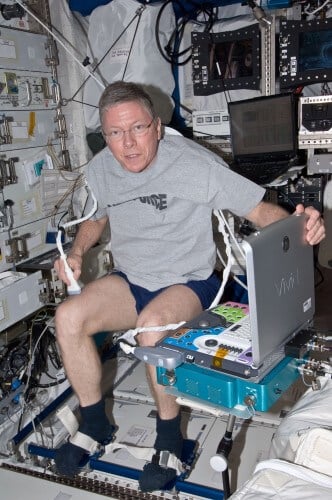An ultrasound device in the field of vascular cardiology, developed in Israel by the health division of the General Electric concern, is currently used by NASA astronauts in a number of studies on the International Space Station * The device (Vivid q) is used for research regarding the effect of space flight on astronauts

Adapted from a General Electric press release.
The health division of the General Electric concern (GE Healthcare) announced that the ultrasound device it developed in the field of vascular cardiology (Vivid q) - is currently in use on the International Space Station, providing important information and monitoring regarding the effect of space flight on the human body.
NASA astronauts and aeronautical researchers use technology aboard the International Space Station (ISS) for cardiovascular research. The Vivid q device is now being used by astronauts for experiments in space, as part of the NASA space agency's human research - with the aim of studying the effect of gravity on astronauts from a long stay on space flights.
Vivid q was developed and manufactured in Israel by the ultrasound group of GE Healthcare. It has been used by the astronauts on the International Space Station for the past few months. The astronauts are aided in the scanning and mapping research by instructions coming from Earth. The data obtained in the study will help a number of contemporary studies of the NASA agency. Among the studies: an integrated study for blood vessels and the heart, which aims to quantify the degree of time, scope and clinical significance of heart atrophy (decrease in the size of the heart muscle) - associated with a long stay in space - and to identify the mechanisms of the atrophy and the consequences for crew members who spend a long time in space.
A study of combined resistance and aerobic or sprint training, to evaluate physical training at high intensity as well as at low intensity - with the aim of reducing the loss of muscle volume, bone, and cardiovascular function of International Space Station crew members during prolonged missions in space. Another study to evaluate the changes in peripheral and central blood vessels of International Space Station crew members during and after exposure to gravity. Future studies will also make use of Vivid q, as it will remain on the space station until at least 2020.
"Our vision when we designed the Vivid q device was to provide excellent imaging capabilities, portability and convenient use, without compromising on performance. Therefore, it is encouraging to see that these aspects are also of great value to the research team on the International Space Station", noted Ilan Lifshitz, CEO of the ultrasound division at GE Healthcare Israel. "Using the device in space conditions is a testament to performance and reliability, and it is an honor for GE that our technology is involved in NASA's human research program."
The size of the Vivid q device is like a laptop computer. The system provides visualization of the heart and blood vessels and enables the evaluation of the heart's function. In addition, the device embodies functions of monitoring, panoramic scanning and two-dimensional Doppler imaging. A device with such capabilities has not been used by NASA in space before. GE says that NASA chose the Vivid q device after a careful and rigorous examination.

One response
The writer probably meant the "effect of the lack of gravity" on the human body.